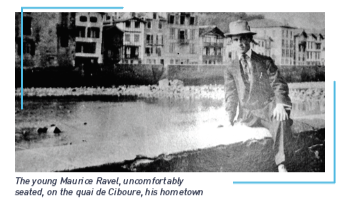Composed 1897, arranged 2012; 14 minutes
Ravel wrote four sonatas and this single movement is the earliest of them. He wrote it in 1897 while a composition student at the Paris Conservatoire, then filed it away. It was first published in 1975, his centennial year, as a Sonate posthume. A decade or so ago, however, a musical autograph by Ravel, came up for auction, referring to the single movement as an ‘unfinished sonata.’ So, this infrequently performed but attractive and already distinctively Ravel-like 11-page fragment could best be viewed as the opening movement of an incomplete violin sonata. A published cello transcription was made by Christian Proske in 2012.
 The sonata’s brief, lyrical and rhythmically elusive theme, first heard on solo cello, foreshadows that of the later Piano Trio (1914) and leads into a movement that falls within the traditional sonata opening movement structure, complete with exposition repeat. Ravel creates an impressive ebb and flow in its music, savoring chromatic and modal harmonies along the way, including a string of parallel chords in the piano in the manner of Delius, the English composer who had been living in Paris for the past decade and whom he had befriended. By emphasizing the lyrical, singing quality of the string instrument, (marked bien chanté at one point), and keeping the piano part generally lean and transparent, Ravel’s finely crafted, sensuous writing for both instruments shows little anxiety over what he would later identify as “two fundamentally incompatible instruments.”
The sonata’s brief, lyrical and rhythmically elusive theme, first heard on solo cello, foreshadows that of the later Piano Trio (1914) and leads into a movement that falls within the traditional sonata opening movement structure, complete with exposition repeat. Ravel creates an impressive ebb and flow in its music, savoring chromatic and modal harmonies along the way, including a string of parallel chords in the piano in the manner of Delius, the English composer who had been living in Paris for the past decade and whom he had befriended. By emphasizing the lyrical, singing quality of the string instrument, (marked bien chanté at one point), and keeping the piano part generally lean and transparent, Ravel’s finely crafted, sensuous writing for both instruments shows little anxiety over what he would later identify as “two fundamentally incompatible instruments.”